 Germany (1906) Scharnhorst, Gneisenau
Germany (1906) Scharnhorst, GneisenauWW1 German Cruisers
Irene class | SMS Gefion | SMS Hela | SMS Kaiserin Augusta | Victoria Louise class | Prinz Adalbert class | SMS Prinz Heinrich | SMS Fürst Bismarck | Roon class | Scharnhorst class | SMS BlücherBussard class | Gazelle class | Bremen class | Kolberg class | Königsberg class | Nautilus class | Magdeburg class | Dresden class | Graudenz class | Karlsruhe class | Pillau class | Wiesbaden class | Karlsruhe class | Brummer class | Königsberg ii class | Cöln class
The last German armoured cruisers: Before the ones you probably know better from ww2, the Scharnhorst and Gneisenau has been Imperial Navy’s most recognizable and famous German cruisers.
Named after famous Prussian generals during the Napoleonic wars, they had been were the ultimate and very best German armoured cruiser, at the end of their lineage, just before the first battlecruisers came out (1906).
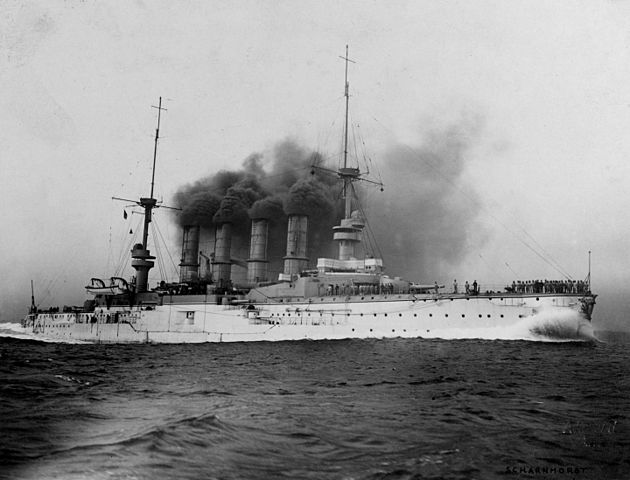
SMS Scharnhorst by Arthur Renard
Development
They had been ordered at Blohm & Voss and Weser shipyards in 1905, launched in March-June 1906 and completed in 1907 and 1908.
Much inspired by previous Roon class of 1903 they retained their general appearance. However, they were much larger, better protected and better armed, thanks to the choice of giving them a new battery of eight 210 mm in turrets and barbettes.
They were designed specifically to successfully oppose their British equivalents, also end of their line, the Minotaur and Shannon.
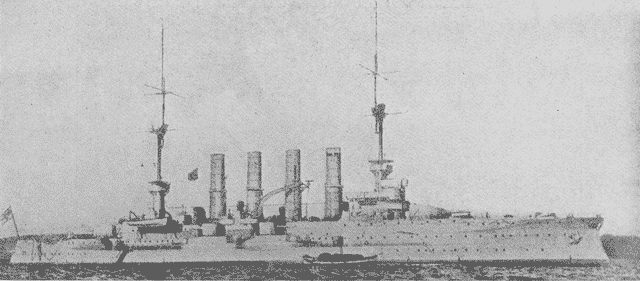
The Roon class was in many ways similar to the Scharnhorst class.
Design
Protection
Both ships had a Krupp armor belt, 150 mm (5.9 in) thick (center), decreasing to 80 mm (3.1 in) on both end of the citadel, down to nothing on ends, and backed with teak planking.
The deck was protected from 60 mm (2.4 in) to 35 mm (1.4 in) and it sloped down to the belt at 40–55 mm thick. Forward conning tower was 200 mm (7.9 in) with a 30 mm roof.
The rear one was 50 mm only with a 20 mm roof. Main battery was 170 mm (6.7 in) with 30 mm roofs. Amidships guns had 150 mm (5.9 in) shields and 40 mm roofs. The secondary guns had 80 mm shields.
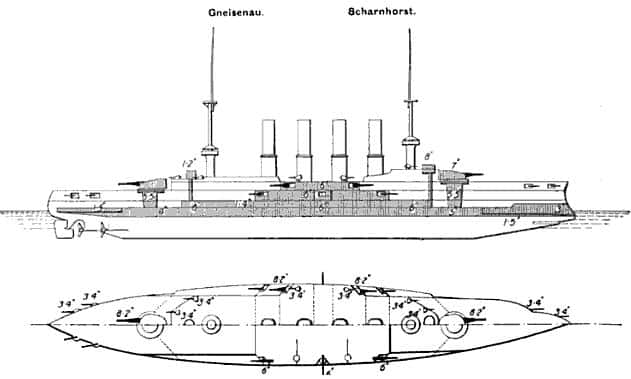
Brassey’s diagram of the class
Powerplant
The machinery was globally the same as the previous Roon class: Three 3-cylinder triple expansion engines, that drove a single propeller each.
Gneisenau’s screws were slightly smaller than her sister-ship. The engines were fed by 18 coal-fired marine-type boilers, and 36 fire boxes.
Total output was about 26,000 metric horsepower (19,000 kW; 26,000 ihp), but on trials bot ships achieved higher speeds at 28,782 ihp for Scharnhorst and 30,396 ihp for Gneisenau.
Scharnhorst topped 23.5 knots and Gneisenau reached 23.6 knots (43.7 km/h; 27.2 mph). Both carried 800 t of coal but had a maximal storage for 2,000 tin case of war.
This made for a 4,800 nautical miles (8,900 km; 5,500 mi) radius at about 14 knots (26 km/h; 16 mph). Their electrical plant was made of four turbo-generators for a total of 260 kilowatts at 110 volts, the last time this voltage was used. In the next Blücher, generators were rated at 225 volts.
Armament
The main armament of these ships was equivalent to the interwar heavy cruiser standard, with eight 210 mm (8.3 in) SK L/40 guns. There were two main turrets fore and aft, and four under single wing turrets at each ends.
Projectiles were 108 kg (238 lb) armor-piercing shells flying at 780 metres per second (2,600 ft/s). The guns achieved a 4–5 rounds per minute, and 700 rounds were carried total. With a 30° elevation, these guns achieved a 12,400 metres (single turrets) to 16,300 metres (17,800 yd) range.
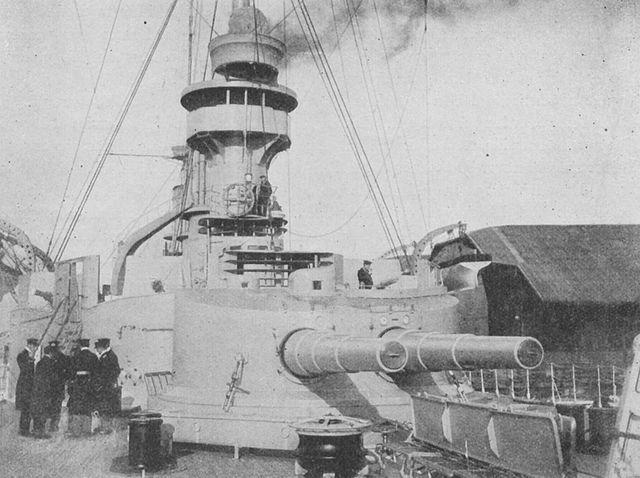
Scharnhorst rear turret
Secondary armament comprises six 15 cm (5.9 in) SK L/40 guns in casemates, capable of 4-5 rpm, with 1,020 rounds in storage. With 20° elevation they were capable of a 13,700 metres (15,000 yd) range.
Their tertiary artillery, quick-firing for anti-torpedo warfare, comprised eighteen 8.8 cm (3.46 in) guns in casemates, firing 10 kg (22 lb) shells at 620 m/s (2,000 ft/s). There was a total of 2,700 rounds in store, and they can fire at 11,000 m (12,000 yd).
There were also four 45 cm (18 in) submerged torpedo tubes, launching a C/03 type torpedo. The latter carried a 176 kg (388 lb) HE warhead at 31 knots (57 km/h; 36 mph), and a range of 1,500 metres (1,600 yd). 11 torpedoes were carried.
Active carrer
Of little use in the Hochseeflotte against because of the profusion of faster, modern battlecruisers, they were transferred to the Pacific squadron under the command of Von Spee, with whom they were going to forge a true legend. In 1909 they were based at Tsing-Tao. With the outbreak of the war and the entry of Japan into the central empires, their place was no longer secure, and the squadron began to wage war on commerce in the eastern Pacific and on the coast West of South America.
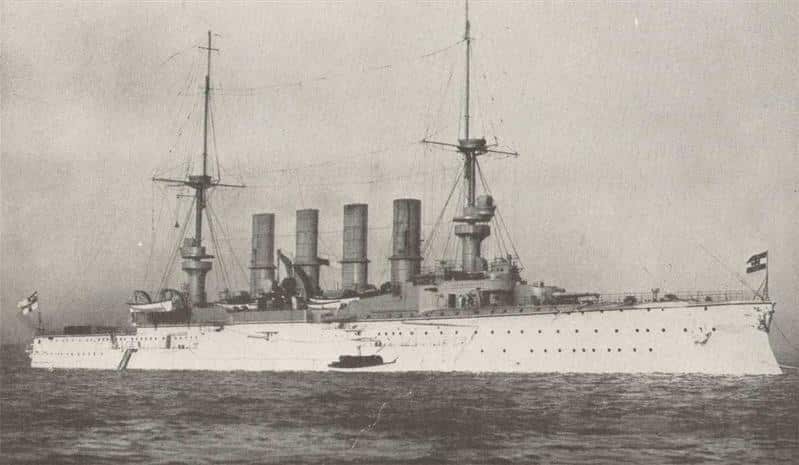
SMS Scharnhorst prewar
The clash took place at Coronel on Nov. 1, 1914. The Good Hope and Monmouth were sunk there, while the Germans took almost no damage. The squadron passed Cape Horn and found itself harassing convoys from Argentina and Brazil.
But a British force was quickly assembled to track down Von Spee. The latter had to fight the awaited return battle on 8 August 1914 off the Falklands.
Faced this time with battle cruisers, the Scharnhorst and the Gneisenau stand little chance but fought with gallantry. Both were sunk but their crew was partly saved.

Two views of the Scharnhorst type.
More on SMS Scharnhorst
Generalleutnant Gerhard von Scharnhorst laid down at Blohm & Voss, Hamburg on January 1905 was commissioned on 24 October 1907. She was Admiral Maximilian von Spee’s flagship at the German East Asia Squadron.
Her crew was esteemed one of the best trained, and like her sister-ship, she won awards for their excellence at gunnery. The declaration of war caught her in the Caroline Islands on a routine cruise.
Japan’s declaration of war soon convinced Spee to depart from Asia, and join Leipzig and Dresden from the American station, and heading for Chile to refuel. The goal was then to return to Germany via the Atlantic Ocean.
However en route he planned also to attack shipping and get rid of Admiral Christopher Cradock’s squadron.
On 22 September, the Scharnhorst attacked Papeete but declined taking the coal stockpiled in the harbor by fear of mines, the coal being burnt anyway in the end. On 1st November 17H PM, Von Spee’s squadron met Admiral Cradock fleet off Coronel.
The German armoured cruiser excelled in this battle, engaging British cruisers at 18 kilometers, then closing to 12 km at about 19H PM. She scored 34 hits on the HMS Good Hope, at least on landing in the ship’s ammunition magazines, which detonated.
The rest of the British ships escaped by the favor of night. While the result was perceived by the First Lord of the admiralty as “the saddest naval action of the war”, the Kaiser ordered 300 iron crosses for the crews upon return.
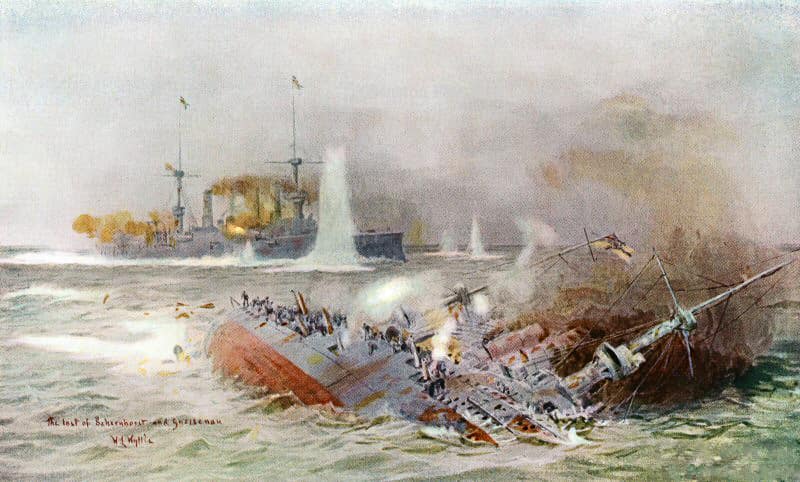
Scharnhorst sinking, with the Gneisenau behind.
However the squadron’s next objective was to destroy the Falklands island radio station after refueling in Valparaiso. Meantime Fisher ordered Admiral John Jellicoe to detach battlecruisers Invincible and Inflexible to catch and destroy Von Spee, under the orders of Vice Admiral Doveton Sturdee.
The squadron also comprised cruisers Carnarvon, Cornwall, Defence, Kent, soon reinforced by the light cruisers Bristol and Glasgow, escaped from Coronel. They arrived at the Falklands by the morning of 8 December, spotting the Germans at 9H40 AM.
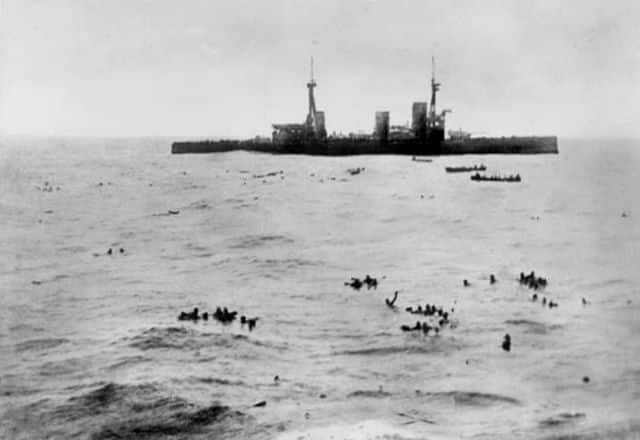
HMS Inflexible picking up Scharnhorst’s survivors.
In turn, Von Spee also spotted them and ordered a retreat. However the worn out ships could not escape the fast battlecruisers, that catch them at 13H20, opening fire at 14 km (8.7 mi), and not ceasing until 15H00, leaving the Scharnhorst a burning wreck, riddled of dozens of 305 mm impacts, listing and later sinking rapidly.
Gneisenau was hit too, by no less than 50 rounds, and sank rapidly, her crew cheering the kaiser before going down. Although hundreds of survivors were picked up, some 2,200 men perished, among which Admiral von Spee, that became a tragic national hero back in Germany.
His memory would be revived through a pocket battleships, one of the three Deutschland class, which also operated in the South Atlantic, while both cruisers would be revived in the next class of German interwar battleships.
Links/Sources
wikipedia.org Scharnhorst class cruiser
On historyofwar.org
On worldwar1.co.uk
On dreadnoughtproject.org

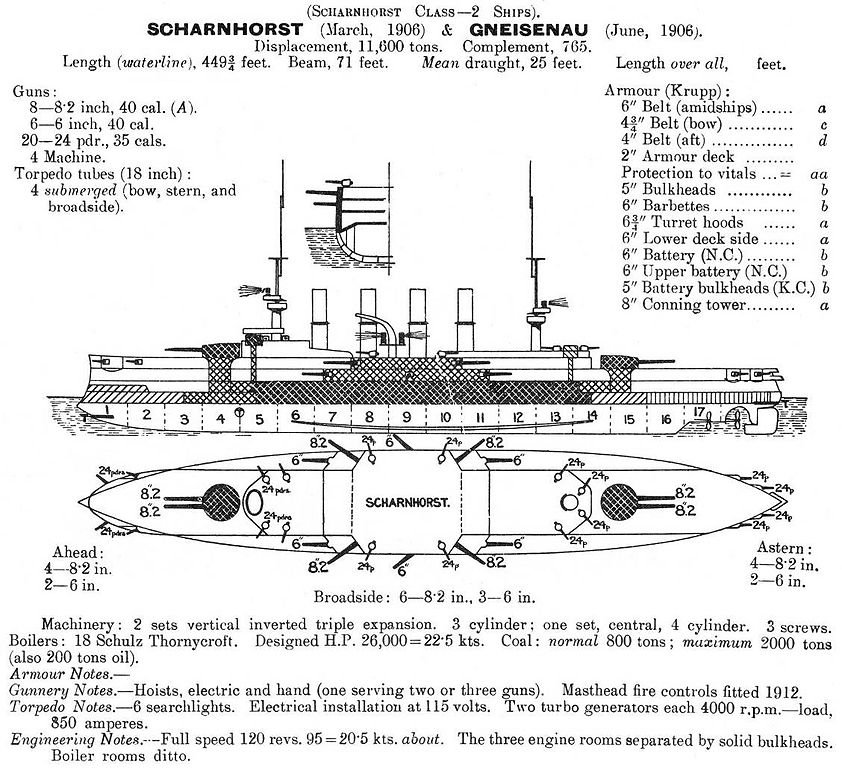

 Latest Facebook Entry -
Latest Facebook Entry -  X(Tweeter) Naval Encyclopedia's deck archive
X(Tweeter) Naval Encyclopedia's deck archive Instagram (@navalencyc)
Instagram (@navalencyc)





 French Navy
French Navy Royal Navy
Royal Navy Russian Navy
Russian Navy Armada Espanola
Armada Espanola Austrian Navy
Austrian Navy K.u.K. Kriegsmarine
K.u.K. Kriegsmarine Dansk Marine
Dansk Marine Nautiko Hellenon
Nautiko Hellenon Koninklije Marine 1870
Koninklije Marine 1870 Marinha do Brasil
Marinha do Brasil Osmanlı Donanması
Osmanlı Donanması Marina Do Peru
Marina Do Peru Marinha do Portugal
Marinha do Portugal Regia Marina 1870
Regia Marina 1870 Nihhon Kaigun 1870
Nihhon Kaigun 1870 Preußische Marine 1870
Preußische Marine 1870 Russkiy Flot 1870
Russkiy Flot 1870 Svenska marinen
Svenska marinen Søværnet
Søværnet Union Navy
Union Navy Confederate Navy
Confederate Navy Armada de Argentina
Armada de Argentina Imperial Chinese Navy
Imperial Chinese Navy Marinha do Portugal
Marinha do Portugal Mexico
Mexico Kaiserliche Marine
Kaiserliche Marine 1898 US Navy
1898 US Navy Sovietskiy Flot
Sovietskiy Flot Royal Canadian Navy
Royal Canadian Navy Royal Australian Navy
Royal Australian Navy RNZN Fleet
RNZN Fleet Chinese Navy 1937
Chinese Navy 1937 Kriegsmarine
Kriegsmarine Chilean Navy
Chilean Navy Danish Navy
Danish Navy Finnish Navy
Finnish Navy Hellenic Navy
Hellenic Navy Polish Navy
Polish Navy Romanian Navy
Romanian Navy Turkish Navy
Turkish Navy Royal Yugoslav Navy
Royal Yugoslav Navy Royal Thai Navy
Royal Thai Navy Minor Navies
Minor Navies Albania
Albania Austria
Austria Belgium
Belgium Columbia
Columbia Costa Rica
Costa Rica Cuba
Cuba Czechoslovakia
Czechoslovakia Dominican Republic
Dominican Republic Haiti
Haiti Hungary
Hungary Honduras
Honduras Estonia
Estonia Iceland
Iceland Eire
Eire Equador
Equador Iran
Iran Iraq
Iraq Latvia
Latvia Liberia
Liberia Lithuania
Lithuania Mandchukuo
Mandchukuo Morocco
Morocco Nicaragua
Nicaragua Persia
Persia San Salvador
San Salvador Sarawak
Sarawak Uruguay
Uruguay Venezuela
Venezuela Zanzibar
Zanzibar Warsaw Pact Navies
Warsaw Pact Navies Bulgaria
Bulgaria Hungary
Hungary

 Bundesmarine
Bundesmarine Dutch Navy
Dutch Navy Hellenic Navy
Hellenic Navy Marina Militare
Marina Militare Yugoslav Navy
Yugoslav Navy Chinese Navy
Chinese Navy Indian Navy
Indian Navy Indonesian Navy
Indonesian Navy JMSDF
JMSDF North Korean Navy
North Korean Navy Pakistani Navy
Pakistani Navy Philippines Navy
Philippines Navy ROKN
ROKN Rep. of Singapore Navy
Rep. of Singapore Navy Taiwanese Navy
Taiwanese Navy IDF Navy
IDF Navy Saudi Navy
Saudi Navy Royal New Zealand Navy
Royal New Zealand Navy Egyptian Navy
Egyptian Navy South African Navy
South African Navy






























 Ukrainian Navy
Ukrainian Navy dbodesign
dbodesign